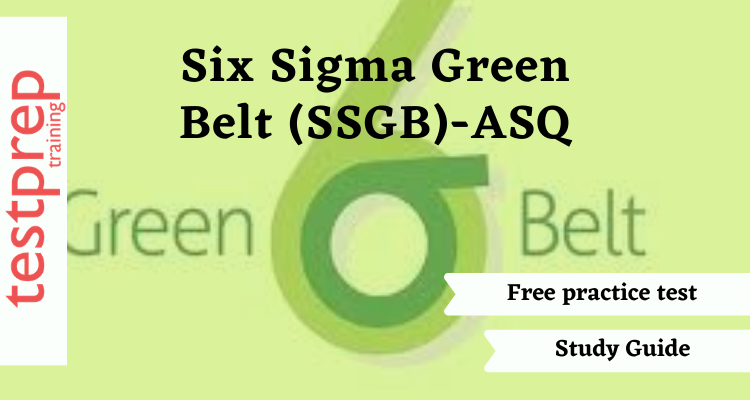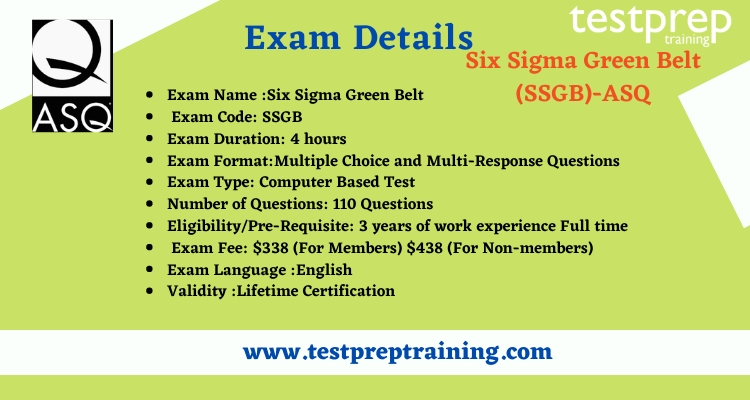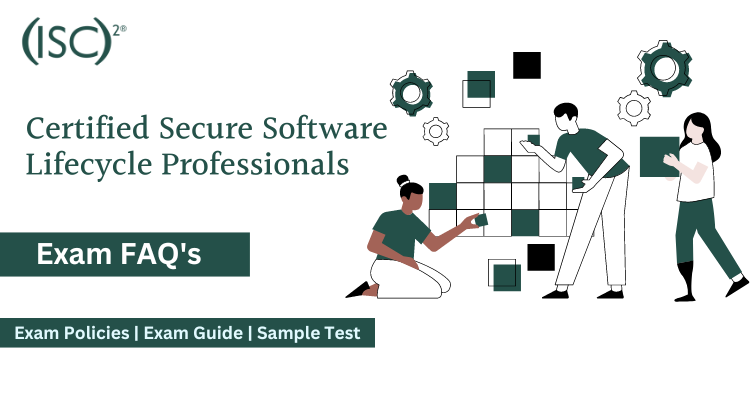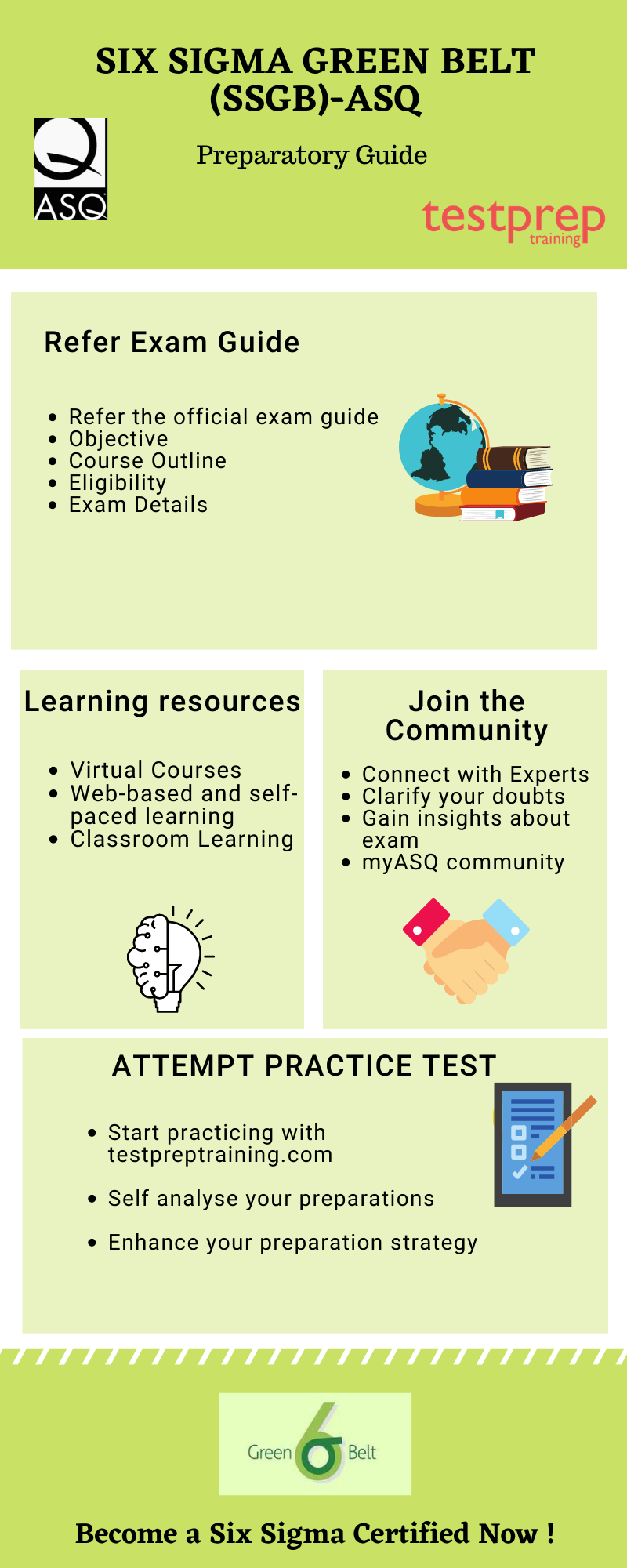Six Sigma Green Belt (SSGB)-ASQ

Six Sigma Green Belt (SSGB)-ASQ operates under Six Sigma Black Belt’s supervision. Green Belt personnel is responsible for analyzing and resolving quality issues in order to improve project quality. It is a candidate and an open book examination. CSSGBs are professionals in spotting problems, analyzing data, and devising cost-cutting strategies that improve quality.
Skills Acquired
After being a certified Six Sigma Belt holder the professional will be able to perform these functions with utmost ease:
- Master Six Sigma methodologies, tools, and techniques (DMAIC, DMADV)
- Build problem-solving, analytical, and business acumen skills.
- Implement successful change management in your company/organization.
- Identify the root cause of a problem and prevent a recurrence.
- Learn process improvement, data analysis, and project management skills.
- Prepares you for a leadership role such as a Certified Six Sigma Black Belt.
You will become a valuable asset to your firm, followed by a fruitful remuneration. You will be able to deliver quality and output to your firm’s functioning:
- CSSGBs can assist your company in identifying current problems and their scope and develop solutions to those problems.
- CSSGBs help achieve the much-needed process improvements leading to cost savings, higher quality, improved delivery, and increased profit margins.
- Using Six Sigma approaches can improve an organization’s products or services to increase marketability.
- By employing a Certified Six Sigma Green Belt, a company will increase the efficiency and utilization of resources within the organization.
Required Experience
Six Sigma Green Belt (SSGB)-ASQ operates under Six Sigma Black Belt’s supervision. Green Belt personnel are responsible for analysing and resolving quality issues in order to improve project quality. It is a candidate and an open book examination. CSSGBs are professionals in spotting problems, analysing data, and devising cost-cutting strategies that improve quality.
Job roles offered after becoming a Six Sigma Green Belt (SSGB) certificate holder
After becoming a Six Sigma Green Belt certified you can work in the following domains and industries:
- Business Process Analyst
- Consultant
- Data Scientist
- Manufacturing Engineer
- Mechanical Engineer
- Operating Systems Specialist
- Process Engineer
- Project Manager
- Quality Manager
- Reliability Engineer
- Six Sigma Green Belt
- Warehouse Operations Manager
Exam Details Six Sigma Green Belt (SSGB)
One can give the Six Sigma Green Belt examination via two methods:
| Computer Delivered mode: | Paper Pencil mode: |
| 110 multiple-choice questions (100 questions are scored and 10 are unscored) | 100-question |
| Exam time is 4 hours and 18 minutes | Exam time is four-hour |
| It is offered in the English language | It is offered in English, Spanish, and Mandarin in certain locations. |
The candidate should bring their own reference material and calculators.

Exam Registration
Follow these steps to successful register yourself for the examination:
- Go to the official ASQ website, or click on the Six Sigma Green Belt exam guide.
- On the left-hand side of the page, you may see a box, click on apply now. Also, below apply now, the dates for the next testing window is mentioned. The candidate can choose a date between any of the dates mentioned.
- Login in to your ASQ account or create a new account on ASQ and follow the prompt.
- Post submitting the application, it takes 1-2 business days to review the online applications and 3-5 for hardcopy applications.
- After ASQ completes the review process you will receive an approval notification via email or a “hold” message explaining that more information is needed for your application to be approved. If it is determined that you do not meet exam requirements, you will receive a refund minus a $70 processing fee.
- Computer-Based Testing, CBT:
- 1-2 business days after you receive your approval notification, you will receive an eligibility email containing instructions on how to schedule your exam with our testing provider Prometric.
- Paper-Based Testing, PBT:
- If you have registered for a Paper-based or translated exam you will not receive an eligibility email. Instead, you will receive a seating letter with your exam date, time, and location approximately 2 weeks before your exam date.
- Schedule your exam appointment in the testing window you chose at the time of application.
For more information visit Six Sigma Green Belt FAQ

Course Structure
I. Overview: Six Sigma and the Organization (11 Questions)
A. Six Sigma and Organizational Goals
1. Value of Six Sigma
- Recognizes why companies utilize Six Sigma
- how they apply their philosophy and aims
- how Six Sigma evolved from quality leaders like Juran, Deming, Shewhart, and Ishikawa. (Understand).
(ASQ Reference: Project Selection Index, The Evolution of Six Sigma)
2. Organizational goals and Six Sigma projects
- Describe how process inputs, outputs, and feedback at all levels may impact the organization as a whole, and identify the links and supports that need to be developed between a selected Six Sigma project and the organization’s goals. (Understand)
(ASQ Reference: Six Sigma)
3. Organizational drivers and metrics
- Recognize major business motivations for all sorts of firms (profit, market share, customer happiness, efficiency, and product differentiation). Learn how essential metrics and scorecards are created, as well as how they affect the whole company. (Understand) (ASQ Reference: Performance metrics)
B. Lean Principles in the Organization
1. Lean concepts
- Define and describe lean concepts such as the theory of constraints, value chain, flow, and perfection. (Apply) (ASQ Reference: Introduction To Lean Principles)
2. Value stream mappings
- Use value stream mapping to identify value-added processes and steps or processes that produce waste, including excess inventory, unused space, test inspection, rework, transportation, and storage. (Understand). (ASQ Reference: Value stream mapping (VSM))
C. Design for Six Sigma (DFSS) Methodologies
1. Road maps for DfSS
- Distinguish between DMADV (define, measure, analyze, design, verify) and IDOV (identify, design, optimize, verify), and recognize how they align with DMAIC. Describe how these methodologies are used for improving the end product or process during the design (DfSS) phase. (Understand) (ASQ Reference: Design For Six Sigma (DFSS))
2. Basic failure mode and effects analysis (FMEA)
- Use FMEA to evaluate a process or product and determine what might cause it to fail and the effects that failure could have. Identify and use scale criteria, calculate the risk priority number (RPN), and analyze the results. (Analyze) (ASQ Reference: FAILURE MODE AND EFFECTS ANALYSIS (FMEA))
3. Design FMEA and process FMEA
- Define and distinguish between these two uses of FMEA. (Apply) (ASQ Reference: FMEA)
4. Process inputs and outputs
- Identify process input and output variables and evaluate their relationships using the supplier, input, process, output, customer (SIPOC) model. (Analyze) (ASQ Reference: More Than Inputs and Outputs)
5. Owners and stakeholders
- Identify the process owners and other stakeholders in a project. (Apply) (ASQ Reference: STAKEHOLDERS)
II. Define Phase (20 Questions)
A. Project Identification
1. Project selection
- describes the project selection process and what factors should be considered in deciding whether to use the Six Sigma DMAIC methodology or another problem-solving process. (Understand). (ASQ Reference: THE DEFINE, MEASURE, ANALYZE, IMPROVE, CONTROL (DMAIC) PROCESS)
2. Process elements
- Define and describe process components and boundaries. Recognize how processes across various functional areas and the challenges that result in process improvement efforts. (Analyze) (ASQ Reference: QUALITY PLAN)
3. Benchmarking
- Understand various types of benchmarking, including competitive, collaborative, and best practices. (Understand) (ASQ Reference: WHAT IS BENCHMARKING?)
4. Process inputs and outputs
- Identify process input and output variables and evaluate their relationships using the supplier, input, process, output, customer (SIPOC) model. (Analyze) (ASQ Reference: SIPOC+CM DIAGRAM)
5. Owners and stakeholders
- Identify the process owners and other stakeholders in a project. (Apply) (ASQ Reference: IDENTIFYING STAKEHOLDERS)
B. Voice of the Customer (VoC)
1. Customer identification
- Identify the internal and external customers of a project, and what effect the project will have on them. (Apply) (ASQ Reference: WHAT IS CUSTOMER SATISFACTION?)
2. Customer data
- Collect feedback from customers using surveys, focus groups, interviews, and various forms of observation. Identify the key elements that make these tools effective. Review data collection questions to eliminate vagueness, ambiguity, and any unintended bias. (Apply) (ASQ Reference: Airport Service Quality (ASQ))
3. Customer requirements
- Use quality function deployment (QFD) to translate customer requirements statements into product features, performance measures, or opportunities for improvement. Use weighting methods as needed to amplify the importance and urgency of different kinds of input; telephone call vs. survey response; product complaint vs. expedited service request. (Apply) (ASQ Reference: WHAT IS QUALITY FUNCTION DEPLOYMENT (QFD)?)
C. Project Management Basics
1. Project charter
- Define and describe elements of a project charter and develop a problem statement that includes baseline data or current status to be improved and the project’s goals. (Apply) (ASQ Reference: Project Charter Template)
2. Project scope
- Help define the scope of the project using process maps, Pareto charts, and other quality tools. (Apply) (ASQ Reference: Project Overview)
3. Project metrics
- Help develop primary metrics (reduce defect levels by x-amount) and consequential metrics (the negative effects that making the planned improvement might cause). (Apply) (ASQ Reference: SELECTING PERFORMANCE MEASURES & METRICS)
4. Project planning tools
- Use Gantt charts, critical path method (CPM), and program evaluation and review technique (PERT) charts to plan projects and monitor their progress. (Apply) (ASQ Reference: PROJECT PLANNING AND IMPLEMENTATION TOOLS)
5. Project documentation
- Describe the types of data and input needed to document a project. Identify and help develop appropriate presentation tools (storyboards, spreadsheet summary of results) for phase reviews and management updates. (Apply)
6. Project risk analysis
- Describe the elements of a project risk analysis, including feasibility, potential impact, and risk priority number (RPN). Identify the potential effect risk can have on project goals and schedule, resources (materials and personnel), costs and other financial measures, and stakeholders. (Understand)
7. Project closure
- Review with team members and sponsors the project objectives achieved in relation to the charter and ensure that documentation is completed and stored appropriately. Identify lessons learned and inform other parts of the organization about opportunities for improvement(apply). (ASQ Reference: Project Overview)
D. Management and Planning Tools
- Define, select, and apply these tools: 1) affinity diagrams, 2) interrelationship digraphs, 3) tree diagrams, 4) prioritization matrices, 5) matrix diagrams, 6) process decision program charts (PDPC), and 7) activity network diagrams. (Apply)
E. Business Results for Projects
1. Process performance
- Calculate process performance metrics such as defects per unit (DPU), rolled throughput yield (RTY), cost of poor quality (CoPQ), defects per million opportunities (DPMO), sigma levels, and process capability indices. Track process performance measures to drive project decisions. (Analyze) (ASQ Reference: WHAT IS PROCESS CAPABILITY?)
2. Communication
- Define and describe communication techniques used in organizations: top-down, bottom-up, and horizontal.(apply) ASQ Parent Communication Tools)
F. Team Dynamics and Performance
1. Team stages and dynamics
- Define and describe the stages of team evolution, including forming, storming, norming, performing, adjourning, and recognition. Identify and help resolve negative dynamics such as overbearing, dominant, or reluctant participants, the unquestioned acceptance of opinions as facts, groupthink, feuding, floundering, the rush to accomplishment, attribution, discounts, digressions, and tangents. (understand). (ASQ Reference: Team Basics)
2. Team roles and responsibilities
- Describe and define the roles and responsibilities of participants on Six Sigma and other teams, including Black Belt, Master Black Belt, Green Belt, champion, executive, coach, facilitator, team member, sponsor, and process owner. (Apply)
3. Team tools
- Define and apply team tools such as brainstorming, nominal group technique, and multi voting. (Apply) (ASQ Reference: Team Tools)
4. Team Communication
- Identify and use appropriate communication methods (both within the team and from the team to various stakeholders) to report progress, conduct reviews, and support the overall success of the project. (Apply)
III. Measure Phase (20 Questions)
A. Process Analysis and Documentation
- Develop process maps and review written procedures, work instructions, and flowcharts to identify any gaps or areas of the process that are misaligned. (Create)B. Probability and Statistics (ASQ Reference: PROCESS ANALYSIS TOOLS)
B. Probability and Statistics
1. Basic probability concepts
- Identify and use basic probability concepts: independent events, mutually exclusive events, multiplication rules, permutations, and combinations. (Apply) (ASQ Reference: Basic Statistics)
- Central limit theorem Define the central limit theorem and describe its significance in relation to confidence intervals, hypothesis testing, and control charts. (Understand)
C. Statistical Distributions
- Define and describe various distributions as they apply to statistical process control and probability: normal, binomial, Poisson, chi square, Student’s t, and F. (Understand) (ASQ Reference: The Probability Handbook)
D. Collecting and Summarizing Data
1. Types of data and measurement scales
- Identify and classify continuous (variables) and discrete (attributes) data. Describe and define the nominal, ordinal, interval, and ratio measurement scales. (Analyze) (ASQ Reference: WHAT IS ATTRIBUTE DATA AND VARIABLE DATA?)
2. Sampling and data collection methods
- Define and apply various sampling methods (random and stratified) and data collection methods (check sheets and data coding). (Apply) (ASQ Reference: WHAT IS A DATA COLLECTION SURVEY?)
3. Descriptive statistics
- Define, calculate, and interpret measures of dispersion and central tendency. Develop and interpret frequency distributions and cumulative frequency distributions. (Evaluate) (ASQ Reference: STATISTICAL METHODS IN QUALITY IMPROVEMENT)
4. Graphical methods
- Construct and interpret diagrams and charts that are designed to communicate numerical analysis efficiently, including scatter diagrams, normal probability plots, histograms, stem-and-leaf plots, box-and-whisker plots. (Create) (ASQ Reference: Statistics)
E. Measurement System Analysis (MSA)
- Calculate, analyze, and interpret measurement system capability using gauge repeatability and reproducibility (GR&R) studies, measurement correlation, bias, linearity, percent agreement, and precision/tolerance (P/T). (Evaluate) (ASQ Reference: Measurement System Analysis)
F. Process and Performance Capability
1. Process performance vs. process specifications
- Define and distinguish between natural process limits and specification limits, and calculate process performance metrics. (Evaluate) (ASQ Reference: Process Capability)
2. Process capability and studies
- Define, describe, and conduct process capability studies, including identifying characteristics, specifications, and tolerances, and verifying stability and normality. (Evaluate) (ASQ Reference: WHAT IS PROCESS CAPABILITY?)
3. Process capability (Cp, Cpk) and process performance (Pp, Ppk) indices
- describe the relationship between these types of indices. Define, select, and calculate process capability and process performance. Describe when Cpm measures can be used. Calculate the sigma level of a process. (Evaluate) (ASQ Reference: Process Capability Indices)
4. Short-term vs. long-term capability and sigma shift
- Describe the assumptions and conventions that are appropriate to use when only short-term data are used. Identify and calculate the sigma shift that occurs when long- and short-term data are compared. (Evaluate)
IV. Analyze Phase (18 Questions)
A. Exploratory Data Analysis
1. Multi-vari studies
- Select appropriate sampling plans to create multi-vari study charts and interpret the results for positional, cyclical, and temporal variation. (Create) (ASQ Reference: Six Sigma, Measurement Systems, and the Hidden Factory)
2. Correlation and linear regression
- Describe the difference between correlation and causation. Calculate the correlation coefficient and linear regression and interpret the results in terms of statistical significance (p-value). Use regression models for estimation and prediction. (Evaluate) (ASQ Reference: Correlation And Regression)
B. Hypothesis Testing
1. Basics
- Distinguish between statistical and practical significance. Determine appropriate sample sizes and develop tests for a significance level, power, and type I and type II errors. (Apply) (ASQ Reference: BASIC QUALITY)
2. Tests for means, variances, and proportions
- Conduct hypothesis tests to compare means, variances, and proportions (paired-comparison t-test, F-test, analysis of variance [ANOVA], chi-square), and interpret the results. (Analyze)
V. Improve Phase (16 Questions)
A. Design of Experiments (DoE)
1. Basic terms
- Define and describe terms such as independent and dependent variables, factors and levels, responses, treatments, errors, repetition, blocks, randomization, effects, and replication. (Understand) (ASQ Reference: WHAT IS DESIGN OF EXPERIMENTS (DOE)?)
2. DoE graphs and plots
- Interpret main effects analysis and interaction plots. (Apply) (ASQ Reference: Design of experiments (DOE))
B. Root Cause Analysis
- Use cause and effect diagrams, relational matrices, and other problem-solving tools to identify the true cause of a problem. (Analyze) (ASQ Reference: Root Cause Analysis)
C. Lean Tools
1. Waste elimination
- Select and apply tools and techniques for eliminating or preventing waste, including pull systems, kanban, 5S, standard work, and poka-yoke. (Apply) (ASQ Reference: WHAT IS LEAN?)
2. Cycle-time reduction
- Use various techniques to reduce cycle time (continuous flow, setup reduction). (Analyze) (ASQ Reference: Cycle-Time Redesign)
3. Kaizen and kaizen blitz
- Define and distinguish between these two methods and apply them in various situations. (Apply) (ASQ Reference: Kaizen Blitz Road Map)
VI. Control Phase (15 Questions)
A. Statistical Process Control (SPC)
1. SPC Basics
- Describe the theory and objectives of SPC, including measuring and monitoring process performance for both continuous and discrete data. Define and distinguish between common and special cause variation and how these conditions can be deduced from control chart analysis. (Analyze) (ASQ Reference: SPC Basics Online)
2. Rational subgrouping
- Define and describe how rational subgrouping is used. (Understand) 3. Control charts Identify, select, construct, and use control charts: X-R, X-s, individual, and moving range (ImR or XmR), median, p, np, c, and u. (Apply)
B. Control Plan
- Assist in developing and implementing a control plan to document and monitor the process and maintain the improvements. (Apply)
C. Lean Tools for Process Control
1. Total productive maintenance (TPM)
- Define the elements of TPM and describe how it can be used to control the improved process. (Understand) (ASQ Reference: Total Productive Maintenance)
2. Visual factory
- Define the elements of a visual factory and describe how it can be used to control the improved process. (Understand) (ASQ Reference: Visual Management)
Preparatory Guide for Six Sigma Green Belt (SSGB)
To succeed on the test, you must have all of the exam preparation tools, including the study guide. This may appear to be a simple task, but having comprehensive test details and appropriate learning materials will be the only way to pass the exam. To begin our preparation, let’s go through them one by one.

Exam Simulator
Exam questions based on the Certified ASQ – Six Sigma Green Belt certification. The question sets may be used in two modes: exam simulation and review mode.
CSSBB Books
As part of the test preparation process, ASQ also provides a guidebook to assist you in passing the open book exam. This will assist you in properly preparing for the examination. In addition to the book, ASQ offers free sample questions and answers to help you prepare for the test.
- ASQ CSSGB HandBook: Can be used in your open book exam.
Certification Preparation: SSGB
Classroom
The participants of ASQ – Six Sigma Black Belt classroom are already practicing Green Belts who want to refresh their knowledge and skills, they will need a hand-held, electronic calculator (such as TI-30Xa) for the course. This course uses a typical instructor-led classroom style and features classroom-based education with the maximum amount of instructor/student contact possible. There are two types of classroom instruction available. View the public and on-site exhibits.
Web-based and self-paced learning
This course is web-based and self-paced. It contains self-paced, internet-based training modules that may include text, graphics, audio, interactive simulations, and quizzes. This course does not teach, but rather reviews the handbook’s topics. A computer and Internet connectivity are required for these web-based courses.
Virtual
These Virtual courses are for Green Belts, individuals supporting Six Sigma projects, and/or individuals looking to achieve their ASQ Six Sigma Green Belt certification. This course is designed to help you prepare for the ASQ SSGB certification test by using real-world examples and exercises. This course examines the SSGB BoK’s ideas. This training course is also available in a classroom environment with an instructor. For parties of five or more, on-site training is offered, which provides convenience, cost savings, and even course flexibility when you bring our top instructors to your company. Please keep in mind that completing this course does not ensure that you will pass the ASQ – Six Sigma Green Belt exam.
Group Training
ASQ’s project offers the company with an on-site training facility. As an employer, you have complete control over when and how you teach and update your staff. This lowers the cost per student, cuts travel costs, and guarantees that the curriculum is tailored to your unique requirements. This assures widespread ASQ – Six Sigma Green Belt certification.
Communities
myASQ communities are utilized for networking, sharing content, and peer-to-peer learning. Some of these communities are gated and are determined by your member profile. Membership in technical and geographic communities are included or can be added to an ASQ membership.
Practice Test with Testprep Training
To ace something, you must practise it, and to practise, you must use sample papers and test series, which will provide you with the experience of a real-time exam. We at Testprep present you with a Six Sigma Green Belt exam series that is specifically created for you. These practise tests are based on the actual examinations, so you may be certain of success if you use them. So, get started now and earn your ASQ – Six Sigma Green Belt certification.

